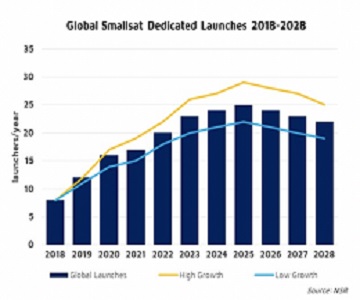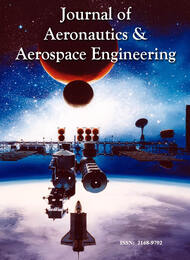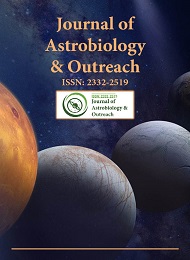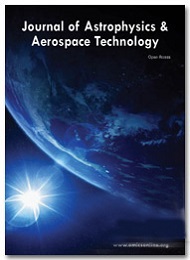Theme: Enlightening the Future Scope of Satellite and Space Research
Satellite-2023
- About Conference
- Why to attend?
- Sessions & Tracks
- Importance & Scope
- Venue & Hospitality
- Participation / presentation option
- Market Analysis
Conference Series LLC LTD is pleased to invite you to participate in the “5th Annual Summit on Satellite and Space Communication Technology” during April 18-19 2023 at Amsterdam, Netherlands, which will integrate keynote presentations, Oral talks, Poster presentations and Exhibitions and special discussions on a wide range of session themes on Satellite, Space Research. Satellite-2023 aims in proclaim knowledge and share new ideas amongst the professionals, industrialists, and students from research areas of satellite, space and all the related disciplines to share their research experiences and indulge in interactive discussions and special sessions at the event.
Satellite-2023 gathering clears a stage to globalize the exploration by introducing an exchange among businesses and scholarly associations and information move from examination to industry. Occasions incorporate hotly debated issues introductions from everywhere the world and expert systems administration with ventures, driving working gatherings and boards. Meet Your Objective Business area with people from and all over the planet focused on learning about Satellite, this is the most obvious opportunity to accomplish the greatest assortment of individuals from wherever all through the World. Direct shows, scatter information, meet with current, make a sprinkle with one more item offering, and get name affirmation at this event.
5th Annual Summit on Satellite and Space Communication Technology is organizing an outstanding Scientific Exhibition/Program and anticipates the world's leading specialists involved in Satellite and Space Research. Your organization will benefit with excellent exposure to the leaders in Satellite and Space Research. You can update your knowledge about the current situation of Satellite and receive name recognition at this 2-day event. Satellite events are an exciting opportunity to showcase new technology. World-renowned speakers, the most recent techniques, tactics, and the newest updates in Satellite and Space Research fields are hallmarks of this conference.
Track 1: Space exploration
Space exploration, the investigation, by means of crewed and unscrewed spacecraft, of the reaches of the universe beyond Earth’s atmosphere and the use of the information so gained to increase knowledge of the cosmos and benefit humanity. The design and manufacturing facilities are located in Southern California, near the Los Angeles space airport, and the propulsion development and structural test facilities are located in Central Texas. The Falcon 9 is a 2-stage launch vehicle powered by LOX/RP engines. The first stage generates 765,000 1bf of thrust (sea-level) using nine Merlin engines, and the second stage generates 96,000 1bf (vacuum) using a single Merlin engine. Both stages use gimbaled engines for guidance. Falcon 9 offers engine-out capability for the first stage.
Track 2: Future of 3D printing in space
3D printing is very useful for aerospace applications on many aspects. Indeed, it could become a major asset for space travels in the future. In aerospace many applications, challenges, innovations related to 3D printing are tuning pace at a higher rate. Step by step, researchers are looking for different applications to this cutting-edge technology in space whereas additive manufacturing is challenging and requires new technologies and resistant materials. With the two different axes of applications arises variant benefits i.e. 3D printing inside of the station and 3D printing outside of the station. Inside it will play role significantly in their daily life in orbits during space exploration, example- when something is broken, and they need to replace a part, it can be long and expensive to send them what they need so they can simply 3D Print it. It is the same thing if a tool is missing. It would be so much easier and time-saving if they could just 3D print their screwdriver when they need it! Regarding the additive technology outside of the station, a 3D printer working in orbit would allow to come up with or create satellite structures. These machines could be integrated inside Nano satellites. Nano satellites could allow to 3D print structures directly in space as well.
Space Weather | 3D printing | Space Telescope | Earth Science | Astronomy Geostationary orbit | Remote sensing | Weather and Climate Observations | GIS techniques | Climate change
Track 3: Space Missions
Currently, Space Missions are spacecraft exploring Mercury, Mars, Venus, and Saturn, as well as a comet and an asteroid. The Voyager spacecraft are move at high speed out of our solar system, while New Horizons speeds toward a 2015 encounter with Pluto. Closer to home, we have probes in lunar orbit, a handful of solar physics missions, space telescopes, and a small army of Earth-observing satellites. In Earth orbit, the International Space Station continues to soar around the planet with a continually Space Missions staffed crew of astronauts and cosmonauts. Satellite conference covers a wide range of topics to innovative space applications while focusing on Earth observation and satellite navigation.
Solar power forecasting | Orbital variations | Satellite Navigation | Space weather | Space Craft | Satellite Sub-system | Space Radiation
Track 4: Satellite Subsystems
Satellite orbits vary greatly, depending on the purpose of the satellite, and are classified in a number of ways. Well-known (overlapping) classes include low Earth orbit, polar orbit, and geostationary orbit. A launch vehicle is a rocket that throws a satellite into orbit. Usually it lifts off from a launch pad on land. Some are launched at sea from a submarine or a mobile maritime platform, or aboard a plane see air launch to orbit. Satellites are usually semi-independent computer-controlled systems. Satellite subsystems attend many tasks, such as power generation, thermal control, telemetry, attitude control and orbit control.
Aerospace engineering | Satellite Launcher | Astronautical engineering | Aircraft structures | Fluid dynamics | Astrodynamics & Astrophysics
Track 5: Satellite Remote Sensing and GIS
A remote sensing instrument collects information about an object or phenomenon within the instantaneous -field -of-view (IFOV) of the sensor system without being in direct physical contact with it. The sensor is located on a suborbital or satellite platform. A geographic information system (GIS) is a system designed to capture, store, manipulate, analyze, manage, and present all types of spatial or geographical data
Track 6: Climate change and Weather forecasting
Climate change is a change in the statistical distribution of weather patterns when that change lasts for an extended period of time (i.e., decades to millions of years). Climate change is caused by factors such as biotic processes, variations in solar radiation received by Earth, plate tectonics, and volcanic eruptions. Weather and forecasting is the application of science and technology to predict the state of the atmosphere for a given location. Weather forecasts are made by collecting significant data about the current state of the atmosphere at a given place and using scientific understanding of atmospheric processes to project how the atmosphere will change.
Track 7: Satellite Navigation and Communication
Satellite Navigation is a system of satellites that provide autonomous geo-spatial positioning with global coverage. It allows small electronic receivers to determine their location (longitude, latitude, and altitude) to high precision (within a few meters) using time signals transmitted along a line of sight by radio from satellites. The signals also allow the electronic receivers to calculate the current local time to high precision, which allows time synchronization. A Satellite Navigation system with global coverage may be termed a global navigation satellite system (GNSS).
Track 8 : Space Environment and its interaction with Spacecraft
Space weather is a branch of space physics and aeronomy concerned with the time-varying conditions within the Solar System, including the solar wind, emphasizing the space surrounding the Earth, including conditions in the magnetosphere, ionosphere, and thermosphere. Space weather is distinct from the terrestrial weather of the Earth's atmosphere troposphere and stratosphere. The science of space weather is focused on fundamental research and practical applications. The term space weather was first used in the 1950s and came into common usage in the 1990s.
Track 9: Aerospace Engineering and Technology
Aerospace engineering is the primary branch of engineering concerned with the research, design, development, construction, testing, science and technology of aircraft and spacecraft. It is divided into two major and overlapping branches: aeronautical engineering and astronautical engineering. Aerospace Engineering and Technology focusing on communications between earth communication stations and space-based communication satellites. The method involves designing Communication satellites, Space Missions, Space Applications, Space Propulsion, designing and building earth stations, Satellite Launcher Technology, repairing and installing satellite communication equipment. Aerospace Engineering deals with the design, construction, and study of the science behind the forces and physical properties of aircraft, rockets, flying craft, and spacecraft. The field also covers their aerodynamic characteristics and behaviors, airfoil, control surfaces, lift, drag, and other properties.
Track 10: Satellite Dish
A satellite dish is a dish-shaped type of parabolic antenna designed to receive or transmit information by radio waves to or from a communication satellite. The term most commonly means a dish used by consumers to receive direct-broadcast satellite television from a direct broadcast satellite in geostationary orbit
Track 11: Small Satellite Operation
Small satellites, miniaturized satellites, or small satellites, are satellites of low mass and size, usually under 500 kg (1,100 lb). While all such satellites can be referred to as "small", different classifications are used to categorize them based on mass. Satellites can be built small to reduce the large economic cost of launch vehicles and the costs associated with construction. Miniature satellites, especially in large numbers, may be more useful than fewer, larger ones for some purposes – for example, gathering of scientific data and radio relay.
Track 12: Asteroid Impact Mission (AIM)
The Asteroid Impact Mission is a small ESA mission of opportunity to explore and demonstrate technologies for future missions while performing a scientific examination on a binary asteroid and addressing planetary defense. Asteroids and comets are very interesting objects, being the remnants of the earliest years of the formation of our Solar System, more than four billion years ago. The word asteroid means "star-like" and these objects appear in the sky as bright, point-like stars. But, unlike stars, asteroids are rocks orbiting our Solar System: they don’t emit light on their own and are visible only because they reflect sunlight.
Track 13: Mobile Satellite Communication Networks
Electronic communication can take place in one-way or two-way transmission mode. One-way communication mode is a simple communication wherein a receiver lacks the ability to communicate back. The two-way communications may be half duplex or full duplex communication wherein a receiver can communicate with the transmitter. A Satellite communication is a technology that is used to transfer the signals from the transmitter to a receiver with the help of satellites. It can be used in different mobile applications that involve communication with the ships, vehicles and radio broadcasting services. The power and bandwidth of these satellites depend on the specifications like complexity, size and cost.
Track 14: LTE-based ground network and satellite networks
LTE (Long-Term Evolution) commonly marketed as 4G LTE, is a standard for wireless of high-speed data for mobile phones and data terminals. It is based on the GSM/EDGE and UMTS/HSPA network technologies, increasing the capacity and speed using a different radio interface together with core network improvements. LTE is the natural upgrade path for carriers with both GSM/UMTS networks and CDMA2000 networks. The different LTE frequencies and bands used in different countries will mean that only multi-band phones will be able to use LTE in all countries where it is supported.
Track 15: Military satellite
A military satellite is an artificial satellite used for a military purpose. The most common missions are intelligence gathering, navigation and military communications. The first military satellites were photographic reconnaissance missions. Some attempts were made to develop satellite-based weapons but this work was halted in 1967 following the ratification of international treaties banning the deployment of weapons of mass destruction in orbit. As of 2013, there are 950 satellites of all types in Earth orbit. It is not possible to identify the exact number of these that are military satellites partly due to secrecy and partly due to dual purpose missions such as GPS satellites that serve both civilian and military purposes.
Track 16: Earth Science
Earth system science (ESS) is the application of systems science to the Earth sciences. In particular, it considers interactions between the Earth's "sphere atmosphere, hydrosphere, cryosphere, geosphere, pedosphere, biosphere and even, the magnetosphere as well as the impact of human societies on these components. At its broadest scale, Earth system science brings together researchers across both the natural and social sciences, from fields including ecology, economics, geology, glaciology, meteorology, oceanography, paleontology, sociology, and space science. Like the broader subject of systems science, Earth system science assumes a holistic view of the dynamic interaction between the Earth's spheres and their many constituent subsystems, the resulting organization and time evolution of these systems, and their stability or instability. Subsets of Earth system science include systems geology and systems ecology, and many aspects of Earth system science are fundamental to the subjects of physical geography and climate science
Track 17: Earth Observation Satellites
A large number of satellites are used today to explore the earth's atmosphere, the oceans, the earth's structure and the biosphere employ a large variety of instruments and techniques from remote sensing and inverse problems to monitor and visualize physical, chemical and biological processes taking place above, in or on the surface of our planet.
Track 18: Earthquake Engineering
Earthquake defines a structure's ability to sustain its main functions, such as its safety and accessibility, at and after a particular earthquake exposure. A structure is normally considered safe if it does not endanger the lives and well-being of those in or around it by partially or completely collapsing. A structure may be considered serviceable if it is able to fulfill its operational functions for which it was designed. Basic concepts of the earthquake engineering, implemented in the major building codes, assume that a building should survive a rare, very severe earthquake by sustaining significant damage but without globally collapsing. On the other hand, it should remain operational for more frequent, but less severe seismic events.
Track 19: Satellite Radiance
Satellite radiance Measure up welling radiation at top of atmosphere. Measure New IR instruments and deep layers generally implies large horizontal scale. Weather satellites do not measure temperature directly but measure radiances in various wavelength bands. Since 1978 Microwave sounding units (MSUs) on National Oceanic and Atmospheric Administration polar orbiting satellites have measured the intensity of upwelling microwave from atmospheric oxygen, which is proportional to the temperature of broad vertical layers of the atmosphere.
Track 20: Orbital Mechanics
Orbital mechanics is the application of ballistics and celestial mechanics to the practical problems concerning the motion of rockets and other spacecraft. Orbital mechanics focuses on spacecraft trajectories, including orbital maneuvers, orbit plane changes, and interplanetary transfers, and is used by mission planners to predict the results of propulsive maneuvers.
Track 21: Satellite Communications
Satellite Communications is telecommunications to use of the artificial satellites to provide the communication links between many points on Earth. It is the use of Satellite Technology in the field of Communications. Satellite Communications play a vital role in the global telecommunications system. Approximately 2,000 artificial satellites orbiting Earth relay analog and digital signals carrying voice, video, and data to and from one or many locations worldwide.
Track 22: Wireless Communication
Wireless communications, is the transfer of data or power between two or more points that are not connected by an electrode. The most common wireless technologies use radio waves. Other examples of applications of radio wireless technology include garage door openers, keyboards and headsets, wireless computer mice, GPS units, headphones, radio receivers, satellite television, cordless telephones and broadcast televison.
Satellite meetings aim to bring together leading academic Scientists, Space Researchers, Professors, Engineers, Business Delegates, Talented Student Communities and Research Scholars to exchange and share their experiences and research results about all aspects of Satellite and Space Research. Satellite conference provides a chance to active researchers to explain the recent progress, trends, advancements in the field of Satellite and Space Research and the solutions they came up with practical problems faced during the phases of research in the field of Satellite and its applications. Satellite 2022 is an international platform aims to gather results from academia and industry partners working in all subfields of Satellite. We try to bring people from different fields, and to create a setting in which they can interact synergistically, and hopefully create new scientific results.
The Satellite events cover a wide range of topics related to innovative space applications while focusing on Earth observation and Satellite Navigation. The Satellite meeting offers key insights into cutting-edge applications from global experts, start-ups, and the winners of Europe's major innovation competitions for space applications.
Major Universities associated with Space and Satellite research
- International School for Advanced Studies
- Libero Istituto Universitario Carlo Cattaneo
- Perugia University
- Politecnico de Milano
- Polite cnico di Milano
- Politecnico di Torino
- Scuola Normale Superiore
- Scuola Superiore di Studi Universitari e di Perfezionamento Sant'Anna
- University degli studi di Brescia
- University degli Studi di Bologna
- University G.d'Annunzio
- University di Cagliari
- University degli Studi di Pavia
- University Institute of Architecture
- University of Catania
- University of L'Aquila
- University of Milano
- University of Modena
- University of Padua
- University of Palermo
- University of Parma
- University of Pisa
- University of Trieste
- University of Udine
- University of Venice
- Technical University of Civil Engineering Bucharest
- Sapienza University of Rome
- University of Rome Tor Vergata
- Roma Tre University
Conference address: Radisson Blu Hotel Amsterdam Airport, Schiphol
Address: Boeing Avenue 2 Amsterdam Airport Schiphol, 1119 PB Schiphol-Rijk, Netherlands
VISA Application: Satellite-2023’s organizing committee hereby reiterates that we are NOT authorized to assist with any Visa application works. You may be required to submit a Letter of Invitation, Letter of Abstract Acceptance and Registration Payment Receipt to the embassy.
Letter of Invitation: A Letter of Invitation is proof that your paper submission and registration application are accepted by the conference committee board. It will be stated in English and may help with your visa application.
Token Amount: Token amount of USD 200 can be paid and a payment receipt can be proof of payment and may help with your VISA application.
**SHOULD YOUR APPLICATION BE DENIED, THE SATELLITE-2023’S ORGANIZING COMMITTEE CAN NOT CHANGE THE DECISION OF THE MINISTRY OF FOREIGN AFFAIRS, NOR WILL WE ENGAGE IN DISCUSSION OR CORRESPONDENCE WITH THE MOFA OR THE EMBASSY ON BEHALF OF THE APPLICANT. THE REGISTRATION FEE WILL BE REFUNDED WHEN THE VISA APPLICATION OF THE INDIVIDUAL IS DENIED AND SHOULD SUBMIT VISA REJECTION PROOF**
Oral presentation: Oral Presentations may include the topics from researches, theoretical, professional or private practices in a concise manner. Individuals with personal experience are also welcome to present personal experiences or narratives which help others in everyday life. Speakers with a 30-minute slot should plan to speak for 20-25 minutes, and Keynote speakers should plan to speak for 40-45 minutes, with the remaining time to be used for questions and discussion by the Session Chair.
Workshop: For workshop presenters also, the topic of the talk will be the same as an Oral presentation with more specialized techniques and detailed demonstration. The generalized time duration for a workshop presentation is about 45-50 minutes. Interested participants can join with their respective team and present the workshop with their research coordinators with special group waivers on registration.
Poster presentation: Student Poster Competition will be organized at the Satellite-2023 conference is to encourage students and recent graduates to present their original research. Presenters will be given about 5-7 minutes to present the poster including questions and answers. Judges may ask questions during the evaluation of the presentation. This is an opportunity for young scientists to learn about the recent findings of their peers to increase their capacity as multidisciplinary researchers. Poster displays will be in hard copy format of 1x1 M long.
For more details regarding Poster Presentation and Judging Criteria view Poster Presentation Guidelines.
Webinar: The webinar presentation is designed for those interested attendees who cannot join in person due to schedule conflicts or other obligations. In this option, the presenter may record the presentation and their presentation will be presented in the Webinar presentation session.
E-Poster: e-Poster is also similar to the webinar presentation. In this session, their presentation will be published in the form of a poster in the conference website and the presenter abstract will be published in the conference souvenir and journal with DOI.
Exhibition: Satellite-2023 has the opportunity to exhibit the products and services from commercial and non-commercial organizations like Drug manufacturers, Clinical Trial Sites, Management Consultants, Chemists, Pharmacists, Business delegates and Equipment Manufacturers.
To know more about exhibitor booth details and benefits visit WHY TO EXHIBIT WITH US?
Send your queries to contact@europeanmeets.com
Advertisement: The conference program is a valuable resource that all attendees refer again and again as they navigate the conference. Advertising in the conference program is a great way to market and can help you secure long term business.
Send your proposal to contact@europeanmeets.com to know the available advertisement options and prices
Sponsor Satellite-2023
Premium Sponsorship package
Additional Sponsorship package
Mail the program manager at contact@europeanmeets.com or WhatsApp on (+44 1138680100) to know more about the sponsorship packages.
The assessment report on Global satellite Market 2022 particularly separates immense arrangements of the business. The assessment servers market size, latest examples, drivers, risks, openings, similarly to key market segments. It relies upon past data and present market needs. In like manner, incorporate specific business approaches recognized by the bosses. That elevates advancement and makes an amazing substitute for the business. The Wireless Communication market will create a tremendous CAGR between 2020 to 2028.
The report disconnects the all-out market dependent on focal members, geographical areas, and segments. Far off correspondence insinuates the correspondence or transmission of information over a distance without requiring wires, connections, or other electrical channels. Distant correspondence is one of the fastest creating ventures in the business world as it is valuable in sending and receiving messages through electronic contraptions and a far-off medium.
The Global satellite Technologies market 2019 assessment gives a principal blueprint of the business including definitions, orders, applications, and industry chain structure. The Global satellite technologies market examination is obliged the overall business areas including improvement designs, genuine scene assessment, and key locale headway status. Progression methodologies and plans are inspected similarly as gathering cycles and cost structures are moreover researched. This report also states import/exchange usage, natural market Figures, cost, worth, pay, and gross edges.

Conference Highlights
- Space exploration
- Future of 3D printing in space
- Space Missions
- Satellite Subsystems
- Satellite Remote Sensing and GIS
- Climate change and Weather forecasting
- Satellite Navigation and Communication
- Space Environment and its interaction with Spacecraft
- Aerospace Engineering and Technology
- Satellite Dish
- Small Satellite Operation
- Asteroid Impact Mission (AIM)
- Mobile Satellite Communication Networks
- LTE-based ground network and satellite networks
- Military satellite
- Earth Science
- Earth Observation Satellites
- Earthquake Engineering
- Satellite Radiance
- Orbital Mechanics
- Satellite Communications
- Wireless Communications
To share your views and research, please click here to register for the Conference.
To Collaborate Scientific Professionals around the World
| Conference Date | April 18-19, 2023 | ||
| Sponsors & Exhibitors |
|
||
| Speaker Opportunity Closed | |||
| Poster Opportunity Closed | Click Here to View | ||
Useful Links
Special Issues
All accepted abstracts will be published in respective Our International Journals.
- Astrophysics & Aerospace Technology
- Journal of Aeronautics & Aerospace Engineering
- Journal of Astrobiology & Outreach
Abstracts will be provided with Digital Object Identifier by





